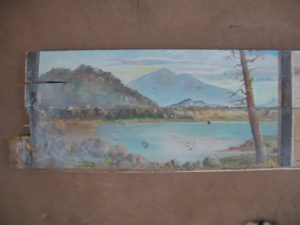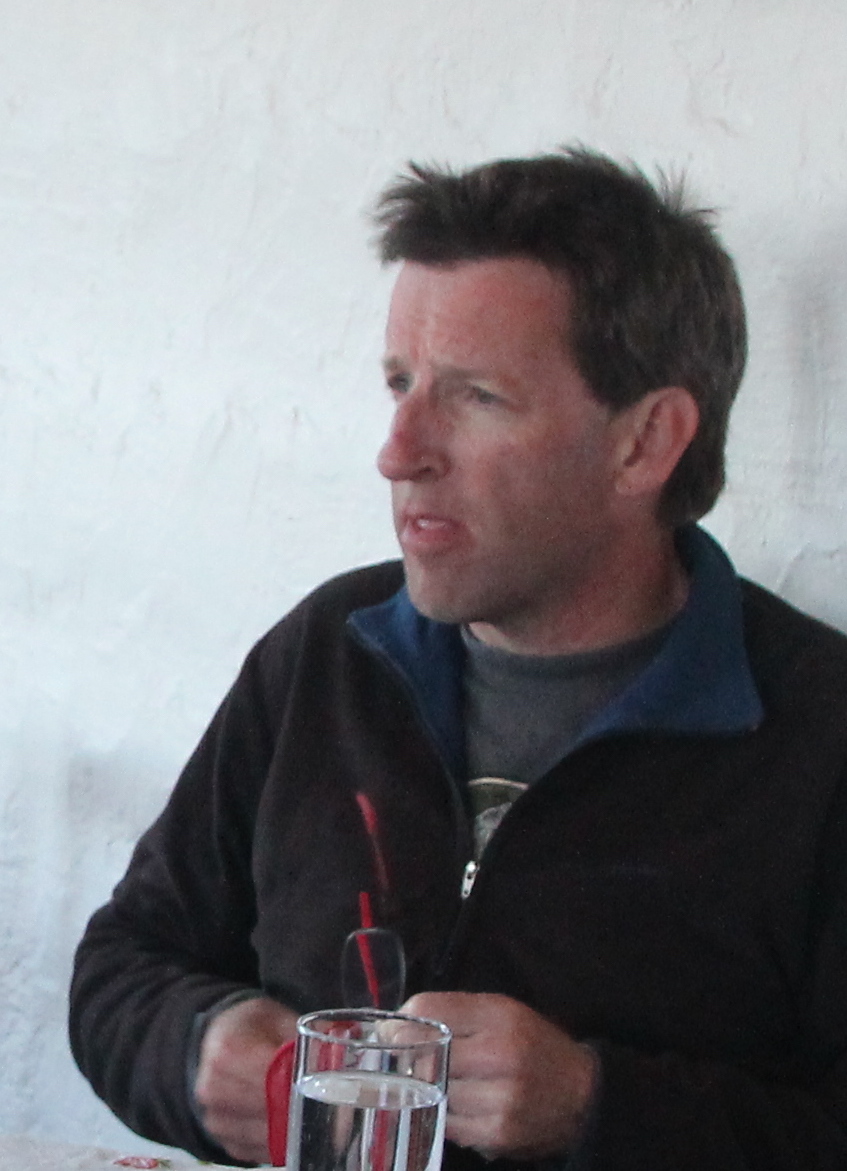 This much is true: it was another year when the world was going to hell.
This much is true: it was another year when the world was going to hell.
1939. Over in Europe, the Nazis were buzzing like a nest of stirred-up hornets soon to boil over their neighbors. In the Pacific, the Japanese were off on their own adventures in conquest. But in Flagstaff, J.A. Bostwick was rendering a peaceful landscape.
I don’t have the full vocabulary for describing what the artist did, choosing colors whose names I don’t know from what was obviously a pretty extensive palette, or using brush strokes in different ways to represent the upward swoosh of some low green shrub or the dots of yellow and orange flowers or the smooth syrup waters of a lake whose striations of blue and green and cream reflect the sky above. I’m not a painter, so I don’t know what to call all those shades of color or the techniques of the strokes.
What I do know is Bostwick painted the lake-and-mountain scene in 1939 because that’s what the signature says, and that the painting is daubed on a couple of plain pieces of conifer siding. When we had a couple of walls torn out last winter, there they were, hidden behind plaster. Now they hang on the wall, a bit marred by nail holes and by the lurching bite of the Sawzall, but in remarkably good shape.
It doesn’t quite look like an accurately rendered northern Arizona scene. The distant silhouette could be that of the Peaks, and the lifeless tree in the foreground does have the gnarled appearance of an old-growth ponderosa veteran. But the rock-bound lake doesn’t really look like anything to be found around Flagstaff. Where did it come from?
But at least as intriguing to me is another question: who was J.A. Bostwick? I’ve got a name, a date and a place, which seems a lot of solidity in the murkiness of the past. For some months now I’ve tried to find out who this artist was. I started with local records. It’s a happy coincidence that one of the city plat maps available online happens to be from 1939. It shows, in old-school ink handwriting, who the owners of lots in Flagstaff were. There’s our lot. The name is hard to read, but it’s certainly not Bostwick.
How about the phone directory? Those are available online too through the city library. There, too, a quick check reveals no one named Bostwick lived in Flagstaff in 1939—or at least no one with a phone.
A visitor, then? A couple of Bostwicks show up as residents of Winslow in that era, but none have first names beginning with J.
Next I tried newspapers.com, a rabbit hole that expands into a vast warren of chambers. I could spend weeks down there, especially when the search term I’m looking for is an uncertain one like J.A. Am I looking for a Jane? John? Joan? There’s no telling. And when I search for “J.A. Bostwick” in the 1930s I get thousands of hits. Most of them are tenuous, or just sheer distractions. I learn, for example, that Pete Bostwick was a well-known jockey in the 1930s who then made the switch to polo. I learn that a member of the Winslow Bostwick family was awarded a Silver Star for heroism flying a B-17 in the Pacific theater during the war, and that he married a local Harvey Girl who worked at La Posada—but that was William E., not J.A.
But there is, finally, one tantalizing clue.
It’s the Arizona Republic, from Sept. 2, 1932, back in an era when the Republic was clearly more of a small-town newspaper than it is now. J.A. Bostwick of 1215 Woodland Ave., it reported, “has returned from a vacation spent in the northern part of the state.”
Some Phoenix city directories are available online at ancestry.com. Using those, it’s easy to learn that Joseph A. Bostwick of that address was a fruit and vegetable inspector and that he was, in 1932, married to the former Mabel Tyler. They’d both come to Arizona from the Midwest, by way of Colorado.
But from there the story grows darker. A 1935 directory reports that the couple’s adult son Glen, married to Luella, lived at the family home and worked in the produce industry. But Joe is no longer living at the same address, and he now has a new partner, Florence. And an obituary from Greenwood Cemetery reveals that Glen, who was born in 1905 in Longmont, Colo., died in 1935 of pulmonary congestion.
In 1940 Mabel shows up on the federal census, living with a roomer around the corner from the former family home. She dies on Sept. 9. Joe, having never divorced Mabel, is free to marry again, and does so only five days later, marrying Florence.
Joe eventually dies too, a couple of decades later, in Riverside, Calif., and Florence marries again in southern Nevada. As far as I can tell there aren’t any surviving descendants of this particular Bostwick family.
Here the trail goes stone cold, or at least veers into speculation just as you might surmise from a clear set of tracks in lakeside mud that a deer wound its way up into a particular copse of woods even though its tracks fade into rock and dry grass long before you get there.
So here’s my story, as likely to be true or false as the scene in the painting is likely to be accurate or made-up. Joseph travels to Flagstaff for vacations in summer—he lives in Phoenix, so why wouldn’t he? For some reason he knows the people who built our house, which dates from the 1930s. And he paints. It’s an idle vacation pastime, low stakes, so why not sketch a vacation souvenir on the newly installed wooden paneling?
How did he get to Flagstaff? He did what travelers had to do in the 1930s: made his way through Prescott, where he stopped to take in the view at the Granite Dells. Maybe that’s the lake in the foreground. Maybe he was vacationing with the woman he loved, even while still legally married to the mother of his son who died an untimely death.
What is the mid-20th-century version of “it’s complicated”? Maybe it’s inexpressible in words, more accurately set in paint in a spot only time will eventually reveal.

